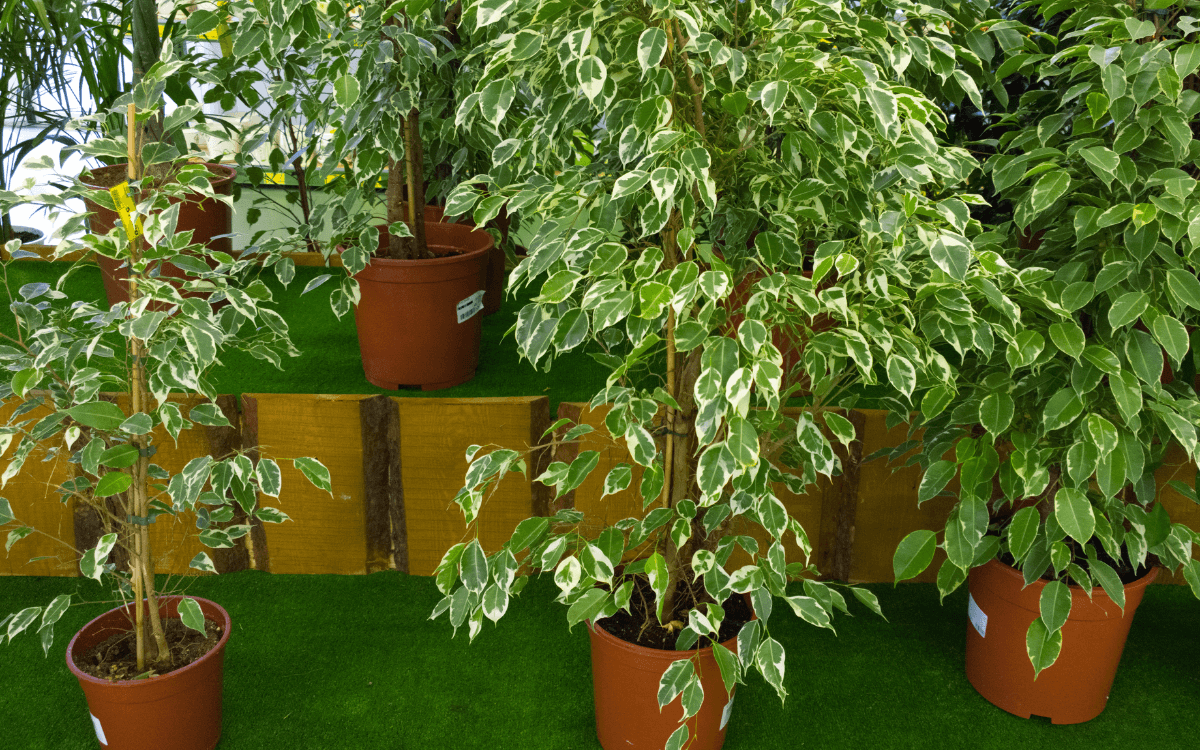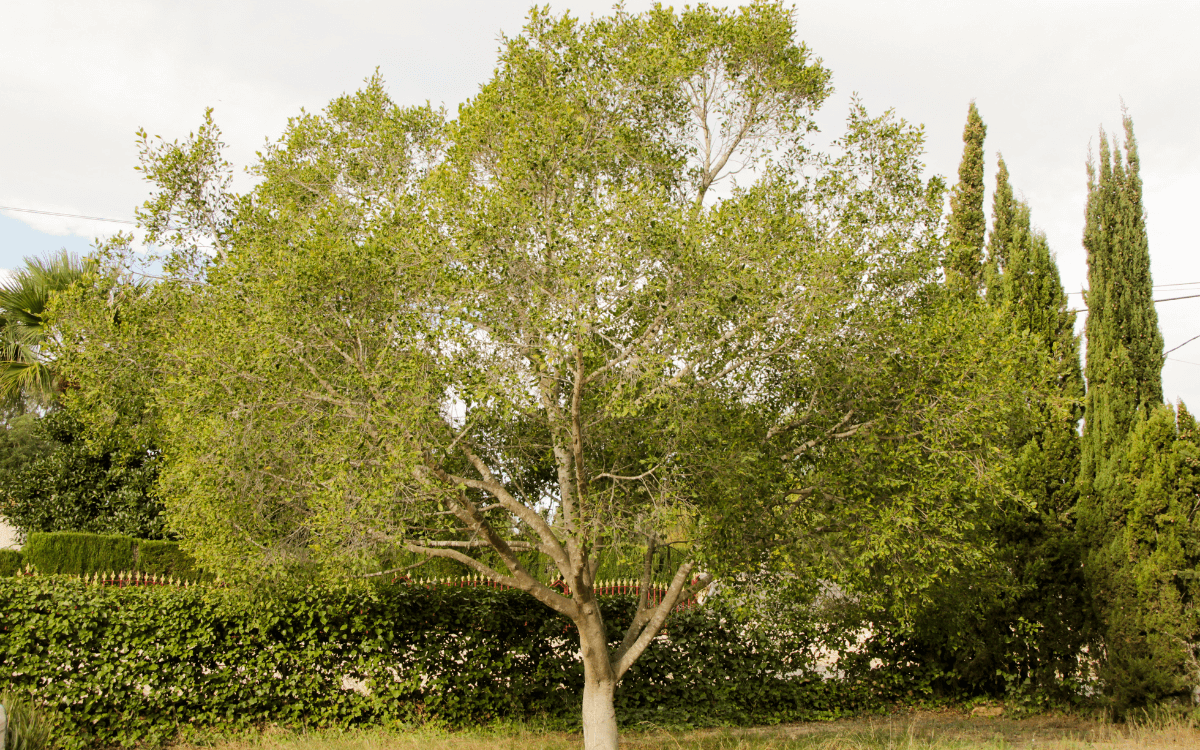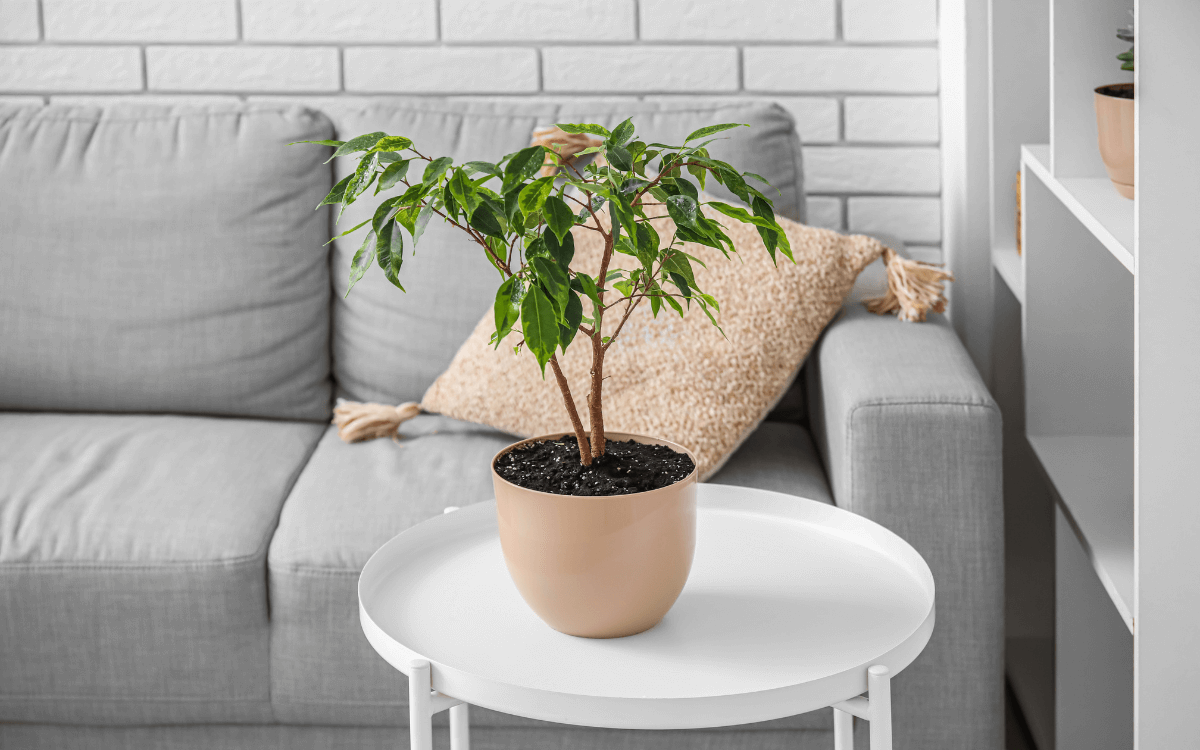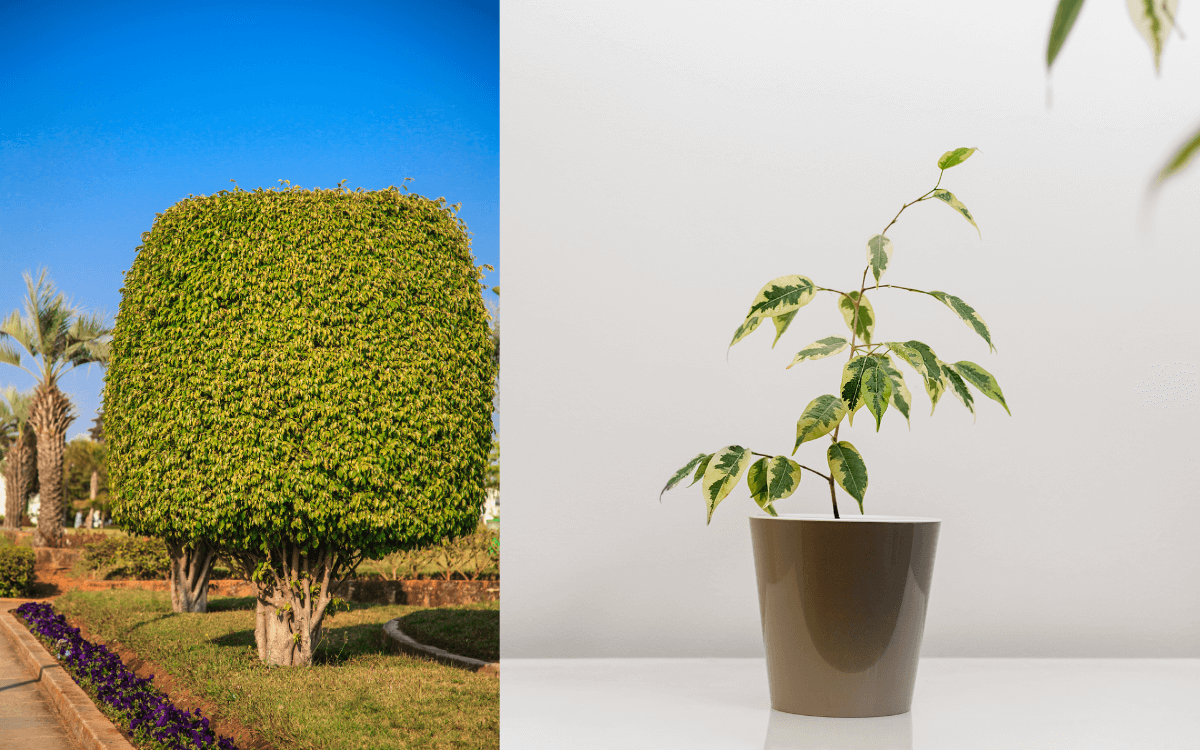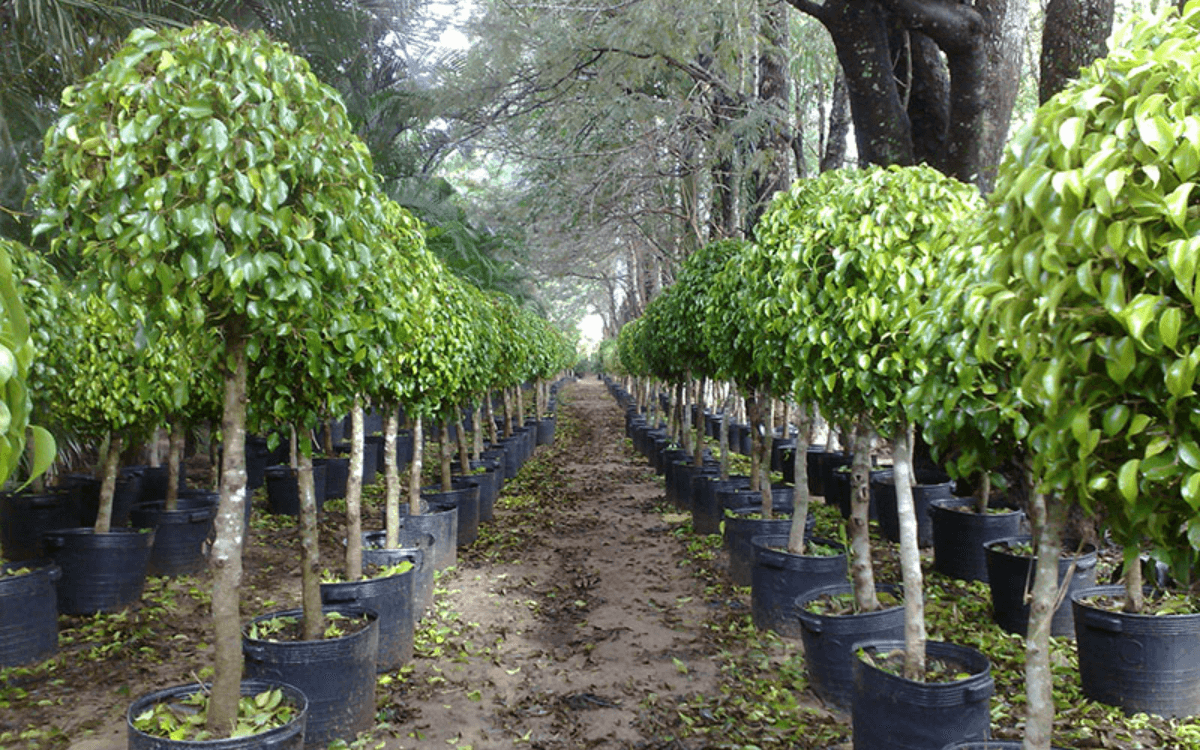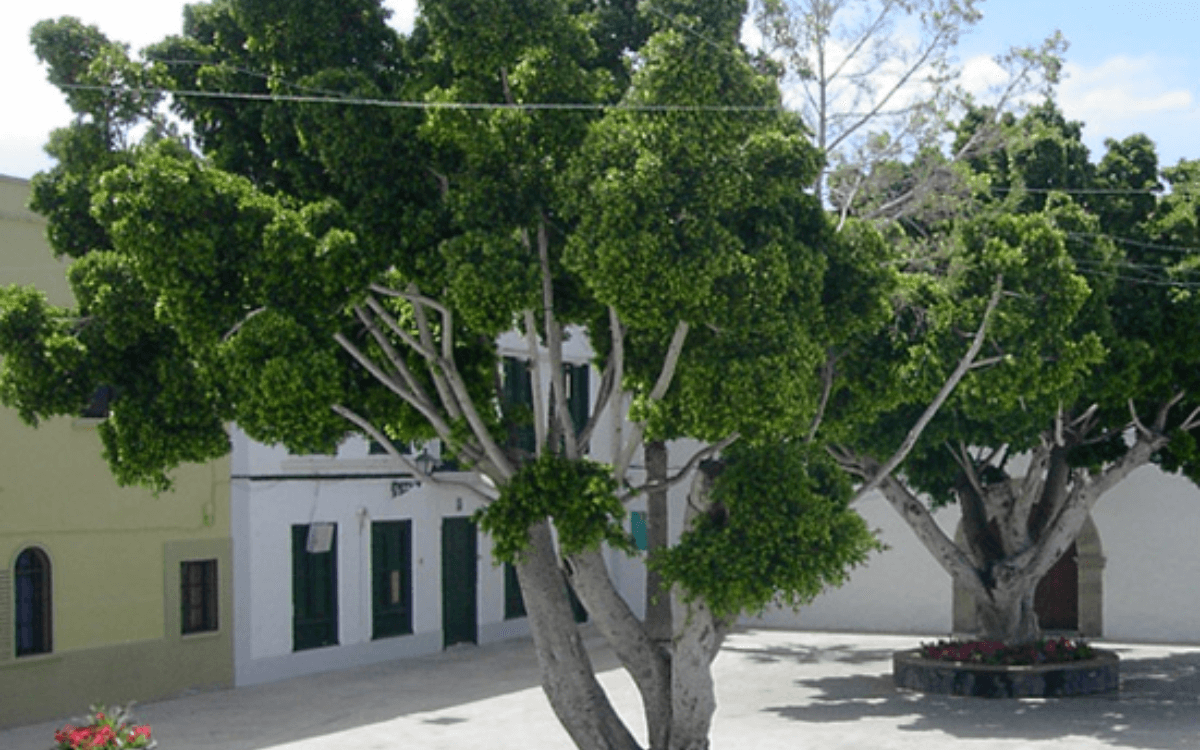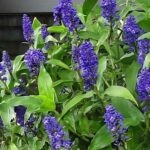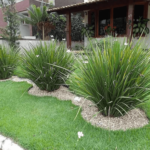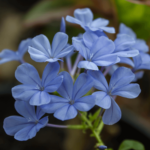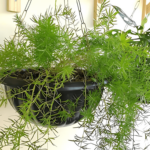The plant Ficus Benjamina, also known as Weeping Fig, is native to Malaysia, and has been gaining space in homes and offices around the world, serving as a living decorative element that brings a touch of nature to indoor environments.
With its beautiful and evergreen leaves, which display a lovely dark hue contrasting with lighter stems, the Ficus Benjamina stands out in various settings.
Keep reading, because, in this article we will dive into the world of this amazing plant, exploring its characteristics, curiosities, and the care necessary to keep it healthy.
Characteristics of the Plant
Ficus Benjamina is a highly adaptable plant that can reach different sizes, making it ideal for various spaces, from small apartments to large living rooms.
Its ability to thrive under low-maintenance conditions makes it a popular choice for those looking to add a green touch to their decor without the need for constant care.
The plant blooms in spring, giving way to small white and yellowish flowers, followed by edible red fruits that are a true invitation to local fauna, especially birds.
Despite its serene appearance, the Ficus Benjamina hides some peculiarities.
- Its roots are known for their rapid growth, which can be a challenge in outdoor environments, where they can invade and damage gardens and structures. Therefore, many cities have specific regulations regarding the planting of this tree in open spaces.
- This plant has a milky sap that can cause irritation, requiring special care when handling it.
If you are looking for a resilient and beautiful plant, the Weeping Fig might be an excellent choice, whether as a tree or bonsai.
Curiosities of the Plant
Below I have compiled some curious information about this plant:
Height: In its natural habitat or when given the freedom to grow without restrictions, the Ficus Benjamina can reach impressive heights, ranging between 15 to 20 meters (49 to 66 feet).
Medicinal properties: The milky sap of the Ficus Benjamina, although toxic upon contact, conceals valuable medicinal properties.
This sap has been traditionally used to treat wounds and bruises, taking advantage of its healing qualities.
Moreover, the plant’s leaves possess antibacterial properties, which intensify with maturity, offering additional health benefits.
Reforestation: The Ficus Benjamina plays a vital role in reforestation projects.
Its introduction into degraded forests assists in the recovery of local biodiversity, providing an ideal habitat for various bird species and contributing to ecological restoration.
Genus Ficus: The Ficus Benjamina is just one of several species within the genus Ficus, which includes representatives in various parts of the world, including the Americas, Asia, and Africa.
Caring for Your Ficus Benjamina
When welcoming a Weeping Fig into your home or office, it’s important to start on the right foot to ensure its flourishing and long-term health.
Here are some tips to follow when receiving this charming plant:
- Careful Inspection: Before finalizing the purchase, take a moment to examine the plant thoroughly. Check for physical damage, signs of disease, or infestation by insects. A healthy plant is the first step towards successful cultivation.
- Adaptation Period: Understand that the Ficus Benjamina needs time to get used to its new environment. This adaptation period can extend over several months. During this time, closely observe the plant to ensure it’s adjusting well.
- Ideal Location: Choose a spot with good natural lighting and adequate ventilation for your Ficus Benjamina. Avoid placing it directly under intense sunlight or in drafts, as these extremes can stress the plant.
- Quarantine: As a precaution, keep the new plant quarantined, separated from others, for a few weeks. This helps prevent the transmission of possible diseases or pests to your other plants.
Below you will learn more details on how to care for this plant.
Ideal Climate
The ideal temperature range for the Weeping Fig varies from 13° to 30°C (55° to 86°F) during the day.
This plant adapts well to cooler climates, as long as it receives adequate sunlight.
However, extreme temperatures should be avoided.
During summer, the temperature should be kept between 23° and 30°C (73° to 86°F) to prevent thermal stress. Exposure to temperatures above this limit can cause burns on the leaves, leaving them whitened.
On the other hand, intense cold can slow down growth or induce a dormancy state in the plant.
At night, it’s recommended to keep the Ficus in cooler temperatures, between 13° and 24°C (55° to 75°F), to simulate the natural cooling cycle.
The Ficus Benjamina flourishes in environments with high to medium humidity, ideally between 30% and 80%. Low humidity can lead to premature leaf drop, a common sign of water stress.
To maintain the ideal humidity, avoid placing the plant near heat sources or air conditioning, which can dry out the surrounding air.
Regular misting or the use of a humidifier can help maintain a moist environment, especially during drier months.
The Ficus Benjamina requires good lighting to thrive, preferring indirect or filtered sunlight.
Direct exposure to the sun, especially during the hottest hours of the day, should be avoided to prevent damage to the leaves.
Furthermore, the plant benefits from adequate ventilation, but should be protected against cold or hot drafts that can stress it.
How to Water
Regular watering is essential, with the ideal frequency generally being once a week. However, this frequency can vary depending on environmental conditions, such as:
- Temperature
- Humidity
- Exposure to light
- Among other factors
Before watering again, it’s important that the soil be dry to the touch.
A good practice is to insert your finger into the soil up to about 1 to 2 centimeters (0.4 to 0.8 inches) deep to check for moisture. If the soil is still moist, postpone watering.
Ensure there is no water accumulation at the bottom of the pot, as this can lead to root rot, affecting the plant’s health.
Pots with good drainage are essential to prevent this problem.
During the active growth months, such as spring and summer, the plant may require more water due to increased metabolism and evaporation. However, in winter, watering should be reduced to reflect the slower growth pace.
Always use room temperature water to water the Ficus Benjamina. Cold water can shock the roots and negatively affect the plant.
When watering, do so evenly around the plant, ensuring that the entire soil in the pot is moistened. Avoid watering directly over the leaves or stem to minimize the risk of fungal diseases.
Ideal Soil
Success in growing Ficus Benjamina begins with choosing the ideal soil, which should provide a perfect balance between moisture retention and adequate drainage.
The composition and texture of the soil are crucial for ensuring healthy root development and, consequently, the overall health of the plant.
The ideal substrate for Ficus Benjamina is a well-balanced mix of garden soil, sand, and organic matter.
Components like pine bark, humus, or peat are excellent for enriching the soil with essential nutrients and improving its structure.
The soil mix should be sufficiently drainable to prevent water accumulation, which can lead to root rot. At the same time, it should be able to retain enough moisture to keep the roots hydrated between waterings.
The soil pH should be in the neutral range, between 6 and 7, to facilitate nutrient absorption by the plant.
Soils that are too acidic or alkaline can prevent the Weeping Fig from accessing the necessary nutrients for its growth.
The choice of pot is as important as the soil.
Prefer pots large enough to accommodate root growth and that have drainage holes to prevent soil waterlogging.
For those unable to find a suitable commercial mix, an alternative is to combine 50% common garden soil with 50% coarse sand to create a light and porous texture.
Leave a space of 5 to 10 centimeters (2 to 4 inches) empty at the top of the pot to facilitate watering without water overflow, ensuring that the soil is moistened evenly.
Fertilization
Opt for a water-soluble fertilizer with a high nitrogen content. Nitrogen is a crucial nutrient that contributes to vigorous foliage growth.
Apply this type of fertilizer every one or two months during the warmer months, like spring and summer, corresponding to the plant’s active growth season.
In indoor environments, where conditions are more controlled, Ficus may require slightly more frequent fertilization due to limited natural resources.
The leaves of the Ficus Benjamina can indicate the need for nutrients.
Yellowing leaves or leaves that fall prematurely may be a sign that the plant needs fertilization.
During winter, when the plant tends to enter dormancy due to reduced sunlight and lower temperatures, fertilization should be reduced or suspended, as the plant will not be in active growth and will not require as many nutrients.
Excessive fertilization can be as harmful as a lack.
Signs of over-fertilization include the accumulation of mineral salts in the soil, which can burn the roots and harm the plant. Always follow the dosage instructions provided on the fertilizer package.
In addition to nitrogen-rich fertilizers, consider also the use of balanced products, with equal proportions of nitrogen, phosphorus, and potassium (NPK).
Slow-release fertilizers are a good option for providing constant nutrition over time.
Organic alternatives, such as composts and worm castings, can also be beneficial, providing nutrients in a more natural way and improving soil structure.
How to Plant and Replant
When planted in pots, the Ficus Benjamina should be replanted every two or three years, or whenever you notice that the current pot is too small for the roots.
The beginning of spring is the ideal time for replanting, taking advantage of the plant’s active growth period.
First, prepare the soil and choose where you will plant it:
- The Weeping Fig can be planted both in large pots and directly in outdoor areas, as long as there is enough space for its growth. Consider that this plant can become quite large, requiring space planning.
- Choose the ideal soil for this plant, based on the information that has already been covered in this text.
- If you opt to plant in a pot, choose one that is large enough to accommodate the growth of the roots and that has drainage holes to prevent water accumulation.
Second, remove your plant from the old pot, clean the roots, and perform the replanting.
- The roots of the Ficus Benjamina are sensitive and can be easily damaged. When replanting, handle them carefully, avoiding burying the plant deeper than it was previously.
- During replanting, it is advisable to carefully prune the roots, removing dead or diseased parts. This not only controls the size of the plant but also stimulates the growth of new healthy roots.
- After replanting, water the plant abundantly to help establish the roots in the new soil. Avoid fertilizing immediately after replanting, giving the plant some time to adjust to the new environment.
How to Prune and Propagate the Ficus Benjamina
Pruning and propagating the Ficus Benjamina are essential practices to maintain health, shape, and promote the propagation of this popular plant.
Here are some guidelines for performing these procedures effectively:
Pruning is necessary to:
- Control the size of the tree
- Remove dry or damaged branches and leaves
- Encourage the emergence of new shoots, keeping the plant healthy and well-shaped.
It should be performed annually, preferably in spring, which is the plant’s active growth period, allowing for a quicker recovery from cuts.
Use sharp and clean pruning shears to avoid transmitting diseases.
It is recommended to prune entire branches instead of making partial cuts, which can weaken the plant. Start pruning from the top and proceed to the base, giving the plant the desired shape.
Propagation of the Ficus Benjamina is commonly done through cuttings.
Cut a piece from a healthy branch, preferably in spring or summer, and remove the tip to stimulate root growth.
The cuttings should be placed in a moist substrate, such as a mix of soil and perlite or vermiculite. Keep the cuttings in a warm and bright location, but away from direct sunlight, until roots develop.
Although less common, some varieties of Weeping Fig that produce fruit can be propagated by seeds. Collect the seeds from ripe fruits and plant them in a moist substrate.
Keep the cuttings or seeds in a high humidity environment, which can be achieved by covering them with a clear plastic until roots form.
After rooting, gradually acclimate the new plants to the environment outside the plastic to avoid shock.
Pests, Diseases, and Other Problems
Despite its popularity and beauty, the Ficus Benjamina is not immune to a number of pests, diseases, and other challenges. Early identification and proper treatment of these issues are essential for the health and longevity of the plant.
Here are some of the main issues that can affect the Ficus Benjamina and how to deal with them:
Mites: These tiny arachnids can cause yellowing and leaf drop. Treatment with organic insecticides or applying water mixed with neutral soap can help control their population.
Mealybugs: These insects produce a waxy substance that resembles small white crusts on leaves and stems. Manual removal with a cotton swab soaked in alcohol or application of neem oil can be effective.
Aphids, White Mold, and Powdery Mildew: Treatment for these issues includes the use of specific insecticides and fungicides.
Fungal and Bacterial Diseases: Manifest through leaf spots, root rot, among other symptoms. Removing affected parts and using appropriate fungicides are recommended.
Environmental Conditions: The Ficus Benjamina can be sensitive to climate changes, pollution, and strong winds. A stable environment is crucial for its health.
Lack or Excess of Water: Both overwatering and underwatering can cause issues such as root rot or plant drying. Maintaining a balance in watering is essential.
Conclusion and Extra Tips
I hope you enjoyed our complete guide on the Weeping Fig.
If you want to learn more about other plants, I have separated some texts that might interest you.
- String of Pearls Plant – Step By Step Care Guide
- Fishbone Cactus (Selenicereus anthonyanus) – Care Guide
- Monkey Tail Cactus: How to Care and Propagate
- Japanese Fern Tree – How to Care and Characteristics
- How to Plant, Grow and Care for Celosia (Step by Step)
- Ixora – A Beautiful Plant to Color Your Garden
- Spanish Moss: Care, Characteristics and Curiosities
And, below are some extra tips and information about this plant:
- Ecological Value: The Ficus Benjamina serves as an important food source for various wild animals, including birds and monkeys, making it an excellent choice for gardens aiming to support local biodiversity.
- Medicinal Properties: This plant has been traditionally used in various cultures to treat conditions such as asthma, urinary infections, and bronchitis, due to its medicinal properties.
- Care with the Sap: The sap of the Ficus Benjamina can cause skin irritation and be toxic if ingested. When pruning or handling the plant, use gloves to protect the skin and avoid direct contact.
- Use of Aerial Roots: The aerial roots of the Weeping Fig can be used in creative ways, such as constructing natural cable networks, adding a unique aspect to landscapes and gardens.
- Varieties: There are various varieties of Ficus Benjamina, some of which have variegated foliage or special flowering. Choosing a variety that suits your taste and the available environment can make the cultivation experience even more enriching.
- Landscaping: Due to its adaptability and aesthetics, the Weeping Fig is often used in landscaping projects to create living fences, hedges, and shading, offering not just beauty but also functionality to spaces.
- Leaf Drop: It is common for the Ficus Benjamina to lose leaves in response to environmental changes, such as moving the plant, changes in watering, or lighting. Normally, this does not indicate a health problem, but an adaptation of the plant to new conditions.
Did you like the text? Then share it on your social networks and also leave a comment below.

